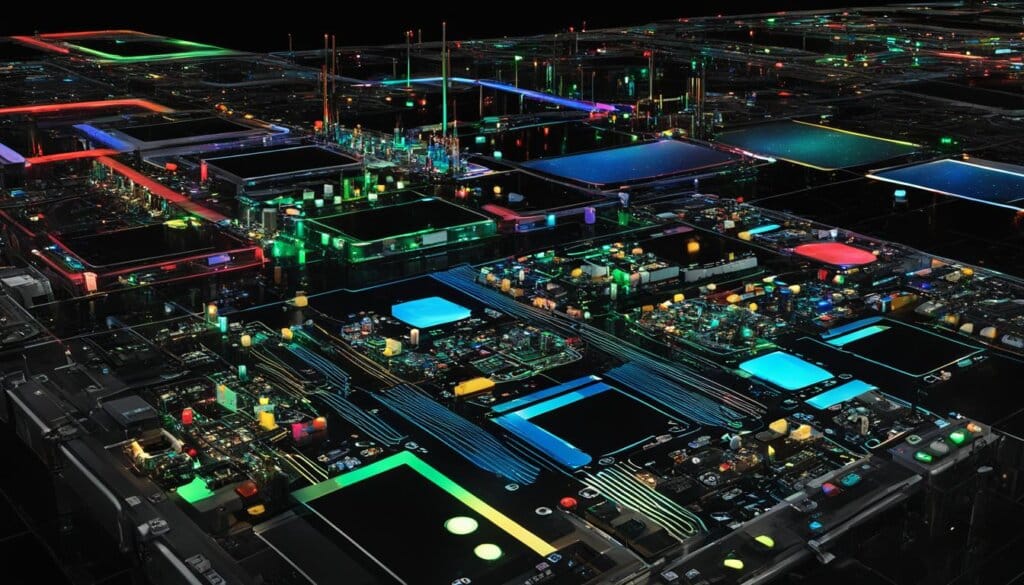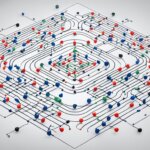Table of Contents
SCADA, or supervisory control and data acquisition, is a crucial aspect of industrial control systems. It involves the acquisition of real-time data from remote locations and the utilization of software applications to monitor and control industrial processes. SCADA systems consist of hardware components, such as sensors, actuators, and field controllers, as well as software components like supervisory computers and HMI software.
In SCADA systems, data acquisition plays a vital role in gathering information from sensors and other devices in the field. This data is then processed and utilized to provide operators with valuable insights and decision-making capabilities. The software applications within SCADA systems enable operators to have a comprehensive understanding of their industrial processes and make data-driven decisions.
The hardware components in SCADA systems, including sensors and field controllers, work together to collect data and control equipment. The software components, such as supervisory computers and HMI software, enable operators to view and interact with the data in a user-friendly manner. With the help of efficient communication infrastructure, SCADA systems enable seamless data exchange between devices and control points.
SCADA systems find applications in various industries, including electricity generation, oil and gas refining, telecommunications infrastructure, transportation and shipping, food and beverage processing, chemical manufacturing, and utilities infrastructure. These systems provide organizations with the necessary tools to monitor, control, and optimize their industrial processes, ultimately enhancing efficiency and productivity.
To gain a deeper understanding of SCADA systems and their components, continue reading the following sections of this article.
What is SCADA and How Does It Work?
SCADA, which stands for supervisory control and data acquisition, is a system of software applications used within industrial processes to control and collect real-time data from remote locations. This sophisticated technology plays a crucial role in monitoring and managing various industrial processes, ensuring efficient operations and informed decision-making.
At its core, SCADA works by gathering data from sensors and actuators installed in the field. These sensors detect inputs from industrial processes, such as temperature, pressure, or flow rates, while the actuators control the mechanisms accordingly. The collected data is then forwarded to a central system for processing and analysis.
SCADA systems comprise both hardware and software components, working seamlessly to facilitate data acquisition and control. The hardware components include sensors, which capture real-time data, and actuators, which allow for remote control of the industrial processes. The software components involve field controllers, which regulate and monitor the interactions between sensors, actuators, and the central system.
SCADA systems are essential for monitoring and controlling various industrial processes, ensuring optimal performance, and maximizing productivity. They enable operators to gather real-time data, efficiently analyze it, and make data-driven decisions to improve efficiency and reliability.
One of the standout features of SCADA is its ability to present the collected data to operators through a human-machine interface (HMI) software. This user-friendly interface allows operators to visualize and interpret data, facilitating effective decision-making. Operators can monitor the real-time data, track historical trends, and respond promptly to any abnormalities or variations in the processes.
Moreover, SCADA systems excel in their capability to operate in remote locations, away from the physical industrial plant. They can collect data from distant field devices, such as oil wells, pipeline networks, or environmental monitoring stations, ensuring comprehensive control and monitoring without the need for on-site personnel.
Key Components of SCADA:
- Sensors: Capture real-time data from industrial processes.
- Actuators: Enable remote control of industrial mechanisms based on collected data.
- Field Controllers: Regulate and monitor interactions between sensors, actuators, and the central system.
- Human-Machine Interface (HMI) Software: Present data to operators in a user-friendly manner.
SCADA systems are invaluable tools for industrial processes, offering real-time monitoring, data acquisition, and remote control capabilities. They revolutionize the way industries manage and optimize their operations, enhancing efficiency, productivity, and safety.
Components of a SCADA System
A SCADA system comprises several components that collaborate to collect and control data, ensuring efficient monitoring and control of industrial processes. These components include:
- Hardware components: The hardware components of a SCADA system consist of sensors and actuators. Sensors detect inputs from industrial processes, such as temperature, pressure, and flow rate, while actuators control the mechanism of the process, adjusting valves, switches, or motors based on the received data.
- Field controllers: Field controllers, such as remote telemetry units (RTUs) and programmable logic controllers (PLCs), play a crucial role in controlling and monitoring the hardware components. They act as intermediaries between sensors, actuators, and the supervisory computer.
- Supervisory computers: Supervisory computers oversee all SCADA processes and gather data from field devices. They serve as the central hub of the system, responsible for processing and analyzing the collected data to make informed decisions.
- HMI software: Human-machine interface (HMI) software provides a visual representation of the data collected by the SCADA system. It presents real-time data, historical data trends, and graphical representations, empowering operators to monitor and control industrial processes effectively.
- Communication infrastructure: The communication infrastructure forms the backbone of a SCADA system. It enables the seamless transmission of data between field devices, field controllers, and supervisory computers, ensuring reliable and secure data collection and control.
These components work in synergy, allowing operators to monitor, control, and optimize industrial processes through a comprehensive SCADA system.

“A SCADA system comprises various hardware and software components that work in unison to collect data, control industrial processes, and enable operators to make informed decisions based on real-time information.”
Features of SCADA Systems
SCADA systems offer a range of features that make them indispensable in industrial processes. Let’s explore these features in detail:
Data Acquisition
At the heart of SCADA systems is the ability to acquire data from various sensors in the field. This data is then fed into the SCADA system for processing, enabling operators to monitor and control industrial processes effectively.
Remote Control
SCADA systems empower operators with the capability to remotely control field actuators based on the data acquired from sensors. This feature allows for swift and efficient adjustments to be made to industrial processes, optimizing performance and ensuring operational efficiency.
Networked Data Communication
Effective communication forms the backbone of SCADA systems. These systems facilitate networked data communication, allowing the seamless transmission of data between field devices, field controllers, and supervisory computers. This ensures that real-time data is readily available, enabling timely decision-making and efficient process control.
Data Presentation
SCADA systems provide operators with a user-friendly human-machine interface (HMI) software. This software enables operators to view and analyze real-time data, as well as access historical data for in-depth analysis and process optimization.
Alarms and Reporting
Alarms play a crucial role in SCADA systems by alerting operators to significant conditions or system abnormalities. Operators can customize alarm settings, ensuring they are promptly notified of any critical events. Reporting features within SCADA systems also allow operators to generate customized reports on system status and performance, facilitating data-driven decision-making and continuous improvement.
In summary, SCADA systems provide a comprehensive set of features that enable efficient data acquisition, remote control, networked data communication, intuitive data presentation, and effective alarms and reporting mechanisms. These features empower operators to optimize industrial processes, enhance productivity, and ensure system stability and reliability.
SCADA Architecture
SCADA systems operate at different levels defined in the Purdue Enterprise Reference Architecture for enterprise integration. Each level plays a crucial role in ensuring comprehensive control and monitoring of industrial processes.
Field Level
The field level of a SCADA system includes essential components such as sensors and actuators. These devices gather data from industrial processes and forward it to local controllers at the direct control level. At this level, the focus is on collecting accurate and real-time data from the field.
Direct Control Level
At the direct control level, local controllers receive data from the field devices and execute control actions based on pre-defined logic. These controllers, usually remote telemetry units (RTUs) or programmable logic controllers (PLCs), play a crucial role in translating the data into actionable commands for the industrial processes.
Plant Supervisory Level
The plant supervisory level acts as a central hub for data aggregation from the level controllers. It integrates the data received and issues commands to the controllers, allowing for coordinated control of multiple processes within a plant. This level plays a critical role in optimizing efficiency and ensuring smooth operations within the plant.
Production Control Level
The production control level of a SCADA system encompasses systemwide supervisory systems. It aggregates data from various plant supervisory systems, providing a high-level view of the overall production processes. Additionally, it produces ongoing reports that aid in decision-making and performance analysis.
Production Scheduling Level
The production scheduling level involves the integration of SCADA systems with business systems used to manage ongoing processes. It ensures that industrial production aligns with the overall business objectives and optimizes scheduling and resource allocation. This level enables organizations to make data-driven decisions that maximize efficiency and productivity.
SCADA system architecture spans from the shop floor to the enterprise network, offering comprehensive control and monitoring capabilities. This multi-level approach enables organizations to streamline operations, improve efficiency, and optimize industrial processes.
With a clear understanding of SCADA architecture, it is now time to explore various use cases and industry examples of SCADA systems.
SCADA Use Cases and Industry Examples
SCADA systems play a crucial role in industrial automation across various industries. Let’s explore some common use cases where SCADA systems are deployed:
- Electricity Generation and Distribution: SCADA systems are used to monitor and control power generation plants, substations, and distribution networks. They ensure efficient electricity generation and reliable power supply.
- Oil and Gas Refining: SCADA systems are employed in oil and gas refineries to optimize production processes, monitor pipelines, and manage storage facilities. They help streamline operations and enhance safety.
- Telecommunications Infrastructure: SCADA systems are essential for monitoring and controlling telecommunication networks. They enable remote management of equipment, ensuring smooth and reliable communication services.
- Transportation and Shipping: SCADA systems are utilized in transportation and shipping industries to monitor and control traffic management systems, railways, airports, and seaports. They help enhance efficiency and safety in transportation operations.
- Food and Beverage Processing: SCADA systems are employed in food and beverage processing plants to monitor and control production processes, temperature, and quality. They ensure compliance with food safety standards and optimize production efficiency.
- Chemical Manufacturing: SCADA systems play a vital role in chemical manufacturing facilities. They monitor and control chemical processes, ensuring accurate ingredient proportions, temperature control, and safe operation.
- Utilities Infrastructure: SCADA systems are used in utility companies to monitor and control water treatment plants, wastewater management systems, and power distribution networks. They optimize resource allocation and enable efficient infrastructure management.
SCADA systems provide organizations with the ability to monitor and control processes remotely, leading to improved efficiency, reduced waste, and data-driven decision-making. They empower industries to closely monitor and fine-tune their operations, enabling them to achieve higher productivity and ensure compliance with industry regulations.
“SCADA systems help industries optimize operations, enhance safety, and improve overall efficiency in various sectors, from electricity generation to utilities infrastructure.”
By leveraging SCADA systems, organizations can benefit from real-time data analysis, predictive maintenance, and effective process control. The integration of SCADA technology across industries revolutionizes the way organizations manage and operate their critical processes.
Industry Examples of SCADA Use Cases
| Industry | Use Case |
|---|---|
| Electricity Generation and Distribution | Monitor and control power plants, substations, and distribution networks |
| Oil and Gas Refining | Optimize production processes, monitor pipelines, and manage storage facilities |
| Telecommunications Infrastructure | Monitor and control telecommunication networks and equipment |
| Transportation and Shipping | Monitor traffic management systems, railways, airports, and seaports |
| Food and Beverage Processing | Monitor and control production processes, temperature, and quality |
| Chemical Manufacturing | Monitor and control chemical processes, ensuring accurate ingredient proportions and temperature control |
| Utilities Infrastructure | Monitor and control water treatment plants, wastewater management systems, and power distribution networks |
Evolution of SCADA Architecture
The architecture of SCADA systems has evolved over time to keep pace with advancements in enterprise computing. As technology has progressed, so too have the capabilities of SCADA, leading to more efficient and flexible industrial control.
In the early days, SCADA systems were implemented using mainframe computers. These powerful machines served as the backbone of industrial control, connecting to field devices such as remote telemetry units (RTUs) and programmable logic controllers (PLCs). With mainframes at the core, SCADA systems were able to collect and process data from industrial processes.
In the 1980s, distributed systems emerged as a breakthrough in SCADA architecture. Local area networks and smaller, more powerful computers enabled the decentralization of control and monitoring functions. This distributed approach allowed for greater flexibility and efficiency in managing data acquisition and control in diverse industrial environments.
Continuing the progression, the 1990s witnessed the rise of networked systems in SCADA architecture. Implementing standard network protocols and improved interoperability, SCADA systems integrated seamlessly with existing networks. This advancement enabled efficient data communication between field devices, controllers, and supervisory computers, facilitating real-time monitoring and control.
Today, modern SCADA systems have adopted web-based architecture, leveraging the power of cloud computing. Web-based systems provide unparalleled scalability and cost-efficiency, allowing organizations to easily expand their SCADA infrastructure and leverage cloud resources for data processing and storage. This architecture enables remote access, facilitates data sharing, and supports collaborative decision-making, leading to enhanced productivity and streamlined operations.
This evolution of SCADA architecture has transformed industrial control, empowering organizations with more effective tools and technologies. The integration of mainframe computers, distributed systems, networked systems, and web-based systems has contributed to improved efficiency, enhanced data communication, and greater flexibility in industrial processes.
Benefits of Modern SCADA
Upgrading to modern SCADA systems offers several benefits over legacy systems. Modern SCADA systems are more scalable, allowing for easier expansion and resource allocation. They also have better interoperability, supporting widely used and modern communications protocols. Modern systems are more likely to be well-supported by vendors and offer more options for support. Legacy systems may rely on proprietary hardware and software, leading to limited support options.
Modern SCADA systems provide organizations with the tools and flexibility to optimize industrial processes, improve efficiency, and adapt to changing technological needs. With their scalability, modern SCADA systems can accommodate the growth of operations, allowing for seamless integration of new equipment and processes. Improved interoperability enables seamless communication between various devices and systems, enhancing data exchange and decision-making processes.
Furthermore, modern SCADA systems benefit from a wider range of support options. Vendors and manufacturers are more likely to provide ongoing support, including regular updates, maintenance, and troubleshooting. This ensures that organizations can rely on a robust and stable SCADA system for their industrial control needs. By leveraging modern SCADA systems, businesses can maximize their operational efficiency, minimize downtime, and stay at the forefront of technological advancements.
FAQ
What is SCADA and how does it work?
SCADA stands for supervisory control and data acquisition. It is a system of software applications used to control industrial processes and collect real-time data from remote locations. SCADA works by gathering data from sensors and actuators in the field and forwarding it to a central system for processing.
What are the components of a SCADA system?
A SCADA system consists of hardware components such as sensors, actuators, and field controllers, as well as software components like supervisory computers and HMI software. These components work together to collect, process, and present data to operators.
What are the key features of SCADA systems?
SCADA systems offer features such as data acquisition, remote control, networked data communication, data presentation through HMIs, and alarms and reporting. These features enable operators to collect and analyze real-time and historical data, control equipment remotely, and receive notifications of significant conditions in the system.
What is the architecture of a SCADA system?
A SCADA system operates at different levels, including the field level, direct control level, plant supervisory level, production control level, and production scheduling level. This architecture allows for comprehensive control and monitoring of industrial processes.
In which industries are SCADA systems commonly used?
SCADA systems are used in various industries such as electricity generation and distribution, oil and gas refining, telecommunications infrastructure, transportation and shipping, food and beverage processing, chemical manufacturing, and utilities infrastructure. They are particularly useful in processes that can be monitored and controlled remotely.
How has the architecture of SCADA systems evolved over time?
The architecture of SCADA systems has evolved from mainframe computers to distributed systems, networked systems, and modern web-based systems that leverage cloud computing resources. This evolution has enabled more effective and flexible industrial control.
What are the benefits of modern SCADA systems?
Modern SCADA systems offer benefits such as scalability, interoperability, and better support options. They allow for easier expansion and resource allocation, support widely used and modern communications protocols, and provide organizations with the tools to optimize industrial processes and adapt to changing technological needs.













